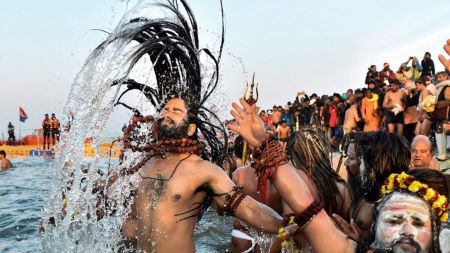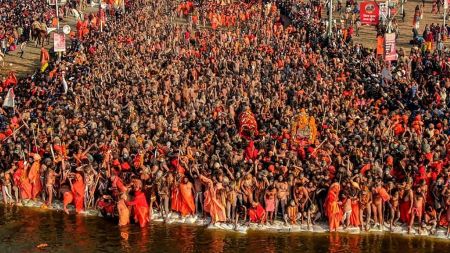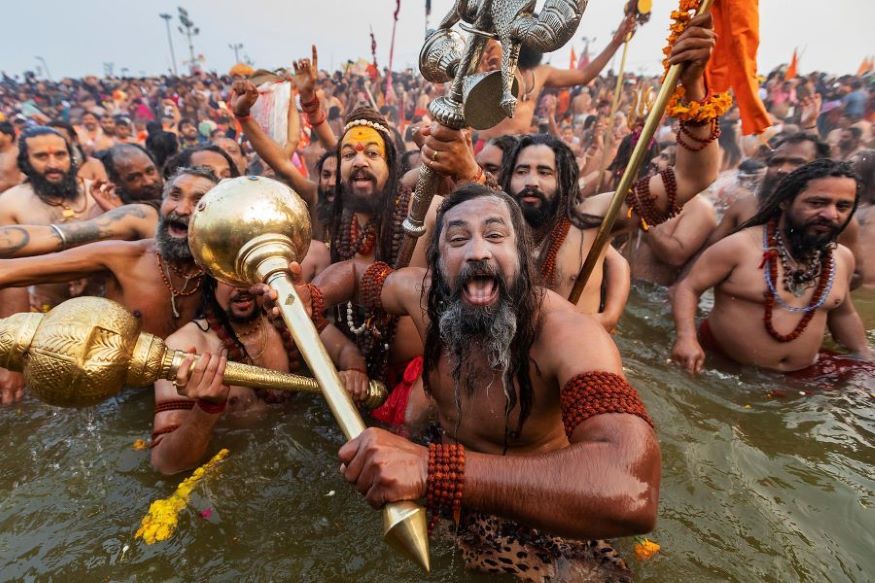What is the importance of Kumbh Mela? Why does it draw millions of people?
THE KUMBH MELA (a religious congregation of Hindus) is commencing in Prayag (Allahabad) in Uttar Pradesh, India, from 13th January this year and will last until 26th February. It is estimated that 400 million people, mostly Hindus, from all over the world will come on this occasion.
The Kumbh Mela, one of the largest religious gatherings in the world, is held every 12 years. This mega-event features several Shahi Snan (royal baths), with key dates including 14th January (Makar Sankranti), 19th January (Paush Purnima), and 16th February (Basant Panchami).
 The Kumbh Mela holds deep religious significance in Hinduism, rooted in the mythology of the churning of the ocean of milk (Samudra Manthan). It is believed that during the Kumbh, celestial alignments create an auspicious time when a dip in the Sangam—the confluence of the Ganga, Yamuna, and the mythical Saraswati rivers—can wash away sins (paap) and grant spiritual merit (punya).
The Kumbh Mela holds deep religious significance in Hinduism, rooted in the mythology of the churning of the ocean of milk (Samudra Manthan). It is believed that during the Kumbh, celestial alignments create an auspicious time when a dip in the Sangam—the confluence of the Ganga, Yamuna, and the mythical Saraswati rivers—can wash away sins (paap) and grant spiritual merit (punya).
The event also showcases India’s cultural diversity, drawing millions of devotees, ascetics, sadhus, and pilgrims from all over the world. Recognized by UNESCO as an intangible cultural heritage, the Kumbh Mela exemplifies the enduring tradition of religious gatherings in India.
Though an atheist, I am a strong supporter of religious freedom. Hence, I have no objection to such congregations.
However, I object to doling out thousands of crores of rupees by the Central and State Government on such gatherings.
The Central Government has announced a special package of ₹2,100 crore for the Maha Kumbh. In total, the Uttar Pradesh government is expected to spend around ₹7,000 crore on infrastructure development, sanitation, security, and publicity. Meanwhile, airfares, hotel tariffs, and local prices have surged as Prayag prepares for the massive influx of visitors.
 Why should such a huge amount be taken from the public coffers for such a religious event—money which should have been spent on the welfare of our people? Funds that could be utilized for addressing critical issues such as poverty, healthcare, and education are instead diverted to facilitate a specific religious congregation.
Why should such a huge amount be taken from the public coffers for such a religious event—money which should have been spent on the welfare of our people? Funds that could be utilized for addressing critical issues such as poverty, healthcare, and education are instead diverted to facilitate a specific religious congregation.
India claims to be a secular country, and that is mentioned in our Constitution. But what kind of secularism is it when huge sums of public funds are spent on constructing a Ram Temple in Ayodhya or on Melas?
Why should such a huge amount be taken from the public coffers for such a religious event?
India’s Constitution defines the nation as a secular state, and Article 51A(h) calls for the promotion of scientific temper among its citizens. Yet, events like the Kumbh Mela, heavily funded by the government, raise pertinent questions about the state’s role in promoting religious activities and perpetuating superstitions.
 Bathing in the Sangam is believed to cleanse one of sins—a notion deeply ingrained in the faith of millions but lacking scientific basis. While individuals are free to hold and practice their beliefs, should the government, which represents a secular state, endorse and finance such practices? This not only undermines secular principles but also diverts resources from pressing societal needs.
Bathing in the Sangam is believed to cleanse one of sins—a notion deeply ingrained in the faith of millions but lacking scientific basis. While individuals are free to hold and practice their beliefs, should the government, which represents a secular state, endorse and finance such practices? This not only undermines secular principles but also diverts resources from pressing societal needs.
People have a bath in the Sangam (the confluence of the Ganga and Yamuna rivers in Prayag) during this event under the belief that this washes off their sins (paap) and earns spiritual benefit (punya).
But is this not sheer superstition and nonsense? How can having a bath wash off sins? One is entitled to be foolish and believe in nonsense. But should the government promote superstitions by financially supporting them? Is this not a violation of Article 51A(h) of the Indian Constitution, which states that it shall be the duty of all citizens (which would include government authorities) to promote the scientific temper?
Some people invited me to come to Allahabad on this occasion. I replied that I have no desire to participate in foolishness and stupidity. ![]()
Also Read:
Thiruppavai – Mystery behind the Song
Disclaimer : PunjabTodayNews.com and other platforms of the Punjab Today group strive to include views and opinions from across the entire spectrum, but by no means do we agree with everything we publish. Our efforts and editorial choices consistently underscore our authors’ right to the freedom of speech. However, it should be clear to all readers that individual authors are responsible for the information, ideas or opinions in their articles, and very often, these do not reflect the views of PunjabTodayNews.com or other platforms of the group. Punjab Today does not assume any responsibility or liability for the views of authors whose work appears here.
Punjab Today believes in serious, engaging, narrative journalism at a time when mainstream media houses seem to have given up on long-form writing and news television has blurred or altogether erased the lines between news and slapstick entertainment. We at Punjab Today believe that readers such as yourself appreciate cerebral journalism, and would like you to hold us against the best international industry standards. Brickbats are welcome even more than bouquets, though an occasional pat on the back is always encouraging. Good journalism can be a lifeline in these uncertain times worldwide. You can support us in myriad ways. To begin with, by spreading word about us and forwarding this reportage. Stay engaged.
— Team PT

